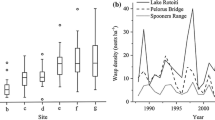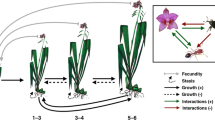Abstract
Supercolonial ants are among the largest cooperative units in nature, attaining extremely high densities. How these densities feed back into their population growth rates and how abundance and extrinsic factors interact to affect their population dynamics remain open questions. We studied how local worker abundance and extrinsic factors (rain, tree density) affect population growth rate and spread in the invasive big-headed ant, which is disrupting a keystone mutualism between acacia trees and native ants in parts of East Africa. We measured temporal changes in big-headed ant (BHA) abundance and rates of spread over 20 months along eight transects, extending from areas behind the front with high BHA abundances to areas at the invasion front with low BHA abundances. We used models that account for negative density dependence and incorporated extrinsic factors to determine what variables best explain variation in local population growth rates. Population growth rates declined with abundance, however, the strength of density dependence decreased with abundance. We suggest that weaker density dependence at higher ant abundances may be due to the beneficial effect of cooperative behavior that partially counteracts resource limitation. Rainfall and tree density had minor effects on ant population dynamics. BHA spread near 50 m/year, more than previous studies reported and comparable to rates of spread of other supercolonial ants. Although we did not detect declines in abundance in areas invaded a long time ago (> 10 years), continued monitoring of abundance at invaded sites may help to better understand the widespread collapse of many invasive ants.



Similar content being viewed by others
References
Abbott K (2005) Supercolonies of the invasive yellow crazy ant Anoplolepis gracilipes, on an oceanic island: forager activity patterns, density and biomass. Insectes soc 52:266–273
Bates D, Maechler M, Bolker B, Walker S (2014) lme4: linear mixed-effects models using Eigen and S4. R package version 1.1-7
Beardsley J Jr, Su T, McEwen F, Gerling D (1982) Field investigations on the interrelationships of the big-headed ant, the gray pineapple mealybug, and pineapple mealybug wilt disease in Hawaii. Proc Hawaiian Entomol Soc 24:51–67
Brook BW, Bradshaw CJA (2006) Strength of evidence for density dependence in abundance time series of 1198 species. Ecology 87:1445–1451. https://doi.org/10.1890/0012-9658(2006)87[1445:Soefdd]2.0.Co;2
Burnham KP, Anderson DR (2002) Model selection and multimodel inference: a practical information-theoretic approach, 2nd edn. Springer, New York
Chang V (1985) Colony revival, and notes on rearing and life history of the big-headed ant. Proc Hawaiian Entomol Soc 25:53–58
Clements CF, Drake JM, Jason IG, Ozgul A (2015) Factors influencing the detectability of early warning signals of population collapse. Am Nat 186:50–58. https://doi.org/10.1086/681573
Cooling M, Hoffmann B (2015) Here today, gone tomorrow: declines and local extinctions of invasive ant populations in the absence of intervention. Biol Invasions 17:3351–3357
Cooling M, Hartley S, Sim DA, Lester PJ (2011) The widespread collapse of an invasive species: Argentine ants (Linepithema humile) in New Zealand. Biol Lett 8:430–433
Dennis B, Ponciano JM, Lele SR, Taper ML, Staples DF (2006) Estimating density dependence, process noise, and observation error. Ecol Monogr 76:323–341
Drake JM, Lodge DM (2006) Allee effects, propagule pressure and the probability of establishment: risk analysis for biological invasions. Biol Invasions 8:365–375
Fabricius JC (1793) Entomologia systematica emendata et aucta. Secundum Classes, Ordines, Genera, Species, Adjectis Synonimis, Locis, Observationibus Descriptionibus. Copenhaguen, 519 pp
Forsman A (2014) Effects of genotypic and phenotypic variation on establishment are important for conservation, invasion, and infection biology. Proc Nat Acad Sci 111:302–307
Gaigher R, Samways MJ, Henwood J, Jolliffe K (2011) Impact of a mutualism between an invasive ant and honeydew-producing insects on a functionally important tree on a tropical island. Biol Invasions 13:1717–1721. https://doi.org/10.1007/s10530-010-9934-1
Gibb H et al (2017) A global database of ant species abundances. Ecology 98:883–884. https://doi.org/10.1002/ecy.1682
Gilbert M, Liebhold A (2010) Comparing methods for measuring the rate of spread of invading populations. Ecography 33:809–817
Goheen JR, Palmer TM (2010) Defensive plant-ants stabilize megaherbivore-driven landscape change in an African savanna. Curr Biol 20:1768–1772
González-Suárez M, Bacher S, Jeschke JM (2015) Intraspecific trait variation is correlated with establishment success of alien mammals. Am Nat 185:737–746. https://doi.org/10.1086/681105
Hastings A et al (2005) The spatial spread of invasions: new developments in theory and evidence. Ecol Lett 8:91–101. https://doi.org/10.1111/j.1461-0248.2004.00687.x
Hodgson EE, Essington TE, Halpern BS (2017) Density dependence governs when population responses to multiple stressors are magnified or mitigated. Ecology 98:2673–2683
Hoffmann BD, Broadhurst LM (2016) The economic cost of managing invasive species in Australia. NeoBiota 31:1
Hoffmann BD, Parr CL (2008) An invasion revisited: the African big-headed ant (Pheidole megacephala) in northern Australia. Biol Invasions 10:1171–1181
Hoffmann BD, Andersen AN, Hill GJ (1999) Impact of an introduced ant on native rain forest invertebrates: Pheidole megacephala in monsoonal Australia. Oecologia 120:595–604
Hoffmann BD, Luque GM, Bellard C, Holmes ND, Donlan CJ (2016) Improving invasive ant eradication as a conservation tool: a review. Biol Cons 198:37–49. https://doi.org/10.1016/j.biocon.2016.03.036
Holway AD (1998) Factors governing rate of invasion: a natural experiment using Argentine ants. Oecologia 115:206–212. https://doi.org/10.1007/s004420050509
Holway DA, Lach L, Suarez AV, Tsutsui ND, Case TJ (2002) The causes and consequences of ant invasions. Annu Rev Ecol Syst 33:181–233. https://doi.org/10.1146/annurev.ecolysis.33.010802.150444
Hu Y et al (2017) By their own devices: invasive Argentine ants have shifted diet without clear aid from symbiotic microbes. Mol Ecol 26:1608–1630. https://doi.org/10.1111/mec.13991
Kaspari M, Byrne MM (1995) Caste allocation in litter Pheidole: lessons from plant defense theory. Behav Ecol Sociobiol 37:255–263
Kaspari M, Vargo E (1995) Does colony size buffer environmental variation? Bergmann’s rule and social insects. Am Nat 145:610–632
Lach L, Hobbs RJ, Majer JD (2009) Herbivory-induced extrafloral nectar increases native and invasive ant worker survival. Popul Ecol 51:237–243
Lester PJ, Gruber MA (2016) Booms, busts and population collapses in invasive ants. Biol invasions 18:3091–3101
Leung B, Drake JM, Lodge DM (2004) Predicting invasions: propagule pressure and the gravity of Allee effects. Ecology 85:1651–1660
Lewis MA, Kareiva P (1993) Allee dynamics and the spread of invading organisms. Theor Popul Biol 43:141–158. https://doi.org/10.1006/tpbi.1993.1007
Loke PY, Lee C-Y (2004) Foraging behavior of field populations of the big-headed ant, Pheidole megacephala (Hymenoptera: Formicidae). Sociobiology 43:211–219
Lowe S, Browne M, Boudjelas S, De Poorter M (2000) 100 of the world’s worst invasive alien species: a selection from the global invasive species database, vol 12. Invasive Species Specialist Group, Auckland
Luque GM, Giraud T, Courchamp F (2013) Allee effects in ants. J Anim Ecol 82:956–965. https://doi.org/10.1111/1365-2656.12091
Manfredini F, Arbetman M, Toth AL (2019) A potential role for phenotypic plasticity in invasions and declines of social insects. Front Ecol Evol. https://doi.org/10.3389/fevo.2019.00375
Morris WF, Doak DF (2002) Quantitative conservation biology: theory and practice of population viability analysis. Sinauer, Massachusetts
O’Dowd DJ, Green PT, Lake PS (2003) Invasional ‘meltdown’on an oceanic island. Ecol Lett 6:812–817
Palmer TM, Young TP, Stanton ML, Wenk E (2000) Short-term dynamics of an acacia ant community in Laikipia. Kenya Oecologia 123:425–435
Palmer TM, Brody AK (2007) Mutualism as reciprocal exploitation: African plant-ants defend foliar but not reproductive structures. Ecology 88:3004–3011
Passera L, Roncin E, Kaufmann B, Keller L (1996) Increased soldier production in ant colonies exposed to intraspecific competition. Nature 379:630–631
Porter SD, Tschinkel WR (1985) Fire ant polymorphism: the ergonomics of brood production. Behav Ecol Sociobiol 16:323–336
R Development Core Team (2019) R: a language and environment for statistical computing. R Foundation for Statistical Computing, Vienna, Austria
Riginos C, Karande MA, Rubenstein DI, Palmer TM (2015) Disruption of a protective ant–plant mutualism by an invasive ant increases elephant damage to savanna trees. Ecology 96:654–661. https://doi.org/10.1890/14-1348.1
Rowles AD, Silverman J (2009) Carbohydrate supply limits invasion of natural communities by Argentine ants. Oecologia 161:161–171
Sagata K, Lester PJ (2009) Behavioural plasticity associated with propagule size, resources, and the invasion success of the Argentine ant Linepithema humile. J Appl Ecol 46:19–27
Shik JZ, Silverman J (2013) Towards a nutritional ecology of invasive establishment: aphid mutualists provide better fuel for incipient Argentine ant colonies than insect prey. Biol Invasions 15:829–836
Sullivan LL, Li B, Miller TEX, Neubert MG, Shaw AK (2017) Density dependence in demography and dispersal generates fluctuating invasion speeds. Proc Natl Acad Sci 114:5053–5058. https://doi.org/10.1073/pnas.1618744114
Tamashiro RA, Milligan PD, Palmer TM (2019) Left out in the cold: temperature-dependence of defense in an African ant–plant mutualism. Ecology 100:e02712. https://doi.org/10.1002/ecy.2712
Tartally A, Antonova V, Espadaler X, Csősz S, Czechowski W (2016) Collapse of the invasive garden ant Lasius neglectus, populations in four European countries. Biol Invasions 18:3127–3131
Tobin PC, Berec L, Liebhold AM (2011) Exploiting Allee effects for managing biological invasions. Ecol Lett 14:615–624
Torres JA, Snelling RR (1997) Biogeography of Puerto Rican ants: a non-equilibrium case? Biodivers Conserv 6:1103–1121
Tschinkel WR (1988) Colony growth and the ontogeny of worker polymorphism in the fire ant Solenopsis invicta. Behav Ecol Sociobiol 22:103–115
Vanderwoude C, Lobry De Bruyn LA, House APN (2000) Response of an open-forest ant community to invasion by the introduced ant Pheidole megacephala. Austral Ecol 25:253–259. https://doi.org/10.1046/j.1442-9993.2000.01021.x
Visitacao JM (2011) Multi-species interactions in African ant-acacias. Harvard University, Cambridge
Wetterer JK (2012) Worldwide spread of the African big-headed ant, Pheidole megacephala (Hymenoptera: Formicidae). Myrmecol News 17:51–62
Wetterer JK, Espadaler X, Wetterer AL, Aguin-Pombo D, Franquinho-Aguiar AM (2006) Long-term impact of exotic ants on the native ants of Madeira. Ecological Entomology 31:358–368
Wilder SM, Holway DA, Suarez AV, LeBrun EG, Eubanks MD (2011) Intercontinental differences in resource use reveal the importance of mutualisms in fire ant invasions. Proc Natl Acad Sci 108:20639–20644. https://doi.org/10.1073/pnas.1115263108
Wills BD, Moreau CS, Wray BD, Hoffmann BD, Suarez AV (2014) Body size variation and caste ratios in geographically distinct populations of the invasive big-headed ant, Pheidole megacephala (Hymenoptera: Formicidae). Biol J Linn Soc 113:423–438. https://doi.org/10.1111/bij.12386
Wilson EO (2003) Pheidole in the New World: a dominant, hyperdiverse ant genus, vol 1. Harvard University Press, Cambridge, Massachusetts, USA
Wittman SE, O’Dowd DJ, Green PT (2018) Carbohydrate supply drives colony size, aggression, and impacts of an invasive ant. Ecosphere 9:e02403. https://doi.org/10.1002/ecs2.2403
Zarada K, Drake JM (2017) Time to extinction in deteriorating environments. Theor Ecol 10:65–71
Acknowledgements
This project was funded by NSF DEB-1556905 awarded to Todd Palmer, Jacob Goheen and Corinna Riginos and NSF DEB-0827610 awarded to Todd Palmer. We thank Ol Pejeta ranch for allowing us to conduct research on this property. The authors want to thank the staff at Ol Pejeta and Mpala ranches in Laikipia, and especially to Gilbert Busienei, Jackson Ekadeli, Scott Carpenter and Brandon Hays who helped with fieldwork. We also want to thank two anonymous reviewers, the GECA lab from IBS-CONICET and the LEAC lab at University of Salta for productive discussions that helped to improve the original versions of the manuscript.
Author information
Authors and Affiliations
Contributions
AGP formulated the idea; AGP, TMP, JRG and CR developed the methodology; AGP and NJM conducted fieldwork; AGP analyzed the data; AGP, JRG, CR and TMP wrote the manuscript.
Corresponding author
Additional information
Communicated by George Heimpel.
Rights and permissions
About this article
Cite this article
Pietrek, A.G., Goheen, J.R., Riginos, C. et al. Density dependence and the spread of invasive big-headed ants (Pheidole megacephala) in an East African savanna. Oecologia 195, 667–676 (2021). https://doi.org/10.1007/s00442-021-04859-1
Received:
Accepted:
Published:
Issue Date:
DOI: https://doi.org/10.1007/s00442-021-04859-1




